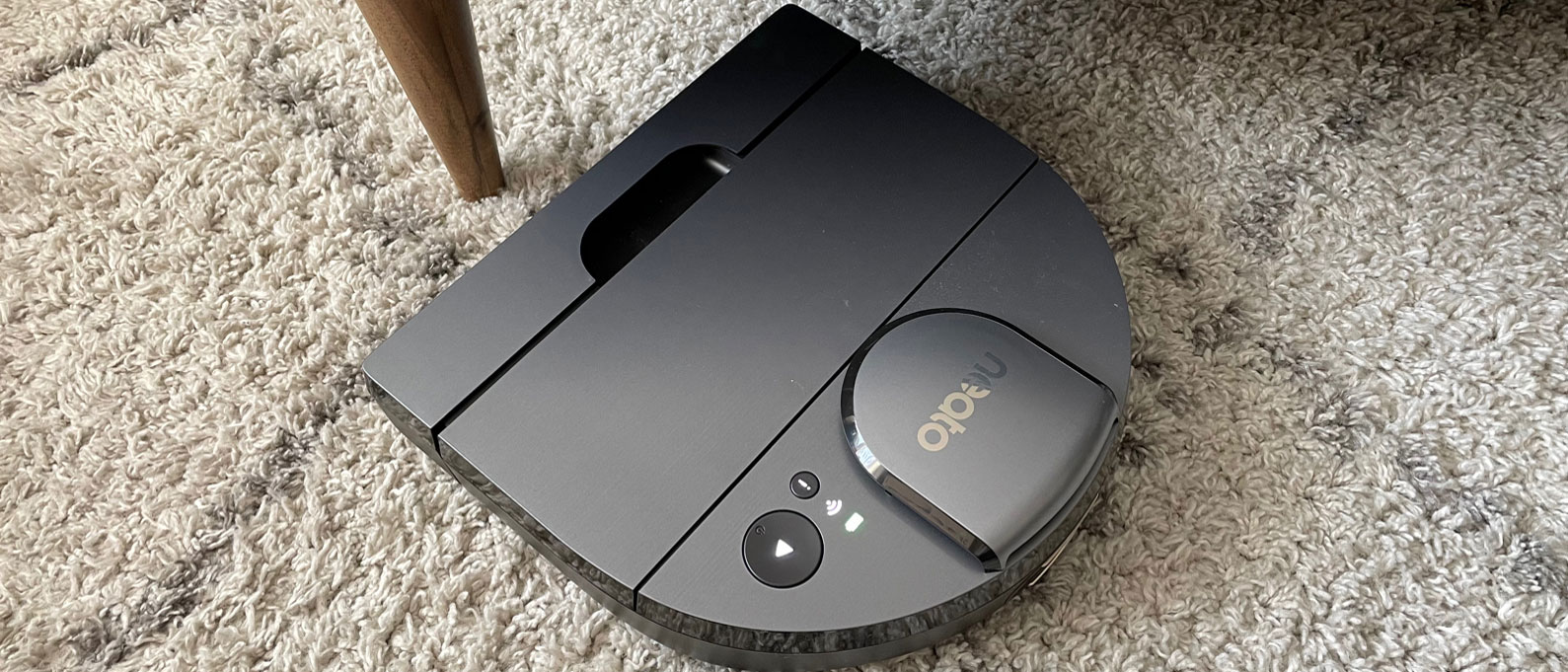Type: Robot
Dustbin capacity: 0.15 gallons
Voice control: Alexa, Google Assistant
Battery life: 300 minutes
Battery charging time: 4 hours
Suitable for: All floor types
Dimensions: 12.7 x 13.2 x 4 in
Weight: 8.07 lbs
Storage: Charging station
Warranty: 1 year, limited
With a track record in designing and making robot vacuums spanning almost 20 years, Neato is one of the original brands on the robot vacuum scene. The Neato D10 is the brand's top-of-the-range robot vacuum and the best of its recently launched trio, which includes the lower-spec D8 and D9 models.
When considering buying one of the best vacuum cleaners cleaning, one of the best robot vacuums is a convenient choice, allowing you to put your feet up while it gets to work. Although most aren’t as powerful as their full-size cousins, when scheduled to clean frequently, a robot vacuum will keep your floors free of debris and dirt.
The Neato D10 features the brand's innovative D-shape for better reach into corners, plus it comes loaded up with smart features and clever technology. Think LIDAR mapping, HEPA filtration, and an app that allows you to set virtual no-go zones and scheduled cleans.
I put this robot through its paces in a real home environment with carpet, hard floors, and all the usual obstacles and furniture to navigate. Tests involved deliberately spilling things like oats and flour to monitor what was collected, alongside noting how it spruced up floors on daily cleans. I also assessed the app to see if it was user-friendly and intuitive.
Read on to see how I got on with Neato’s top cleaning robot. Spoiler alert: it’s good but not perfect.
Neato D10: Price & availability
- $599.99 / £555
The D10 is Neato’s top-of-the-range robot vacuum, which means it’s also the most expensive model you can buy from the brand. But the price is competitive when compared to other top-spec robot vacuums.
It’s available to buy directly from Neato as well as other retailers, including Amazon.
Neato D10: First impressions
The D10 comes in a compact box, and the molded protective inserts, along with the majority of the packaging, are all easily recyclable cardboard. The vacuum and charger are further protected by fabric-style bags.
Other than positioning the charger and placing the robot on the chargers for its first charge, there’s very little physical setup and assembly required. All the setup is in configuring the app, which is straightforward as long as you know your Wi-Fi password.
The app guides you through the setup and there are additional instructions and helpful hints in the user manual. Overall, the manual provides all the information needed for the setup and ongoing maintenance of the vacuum in an easy-to-read combination of text and images.
Neato D10: Design
The D-shaped robot vacuum is an innovation that’s become synonymous with Neato, and the D10 features this clever design. However, its polished, brushed metallic finish gives this model a smarter and more premium appearance than its cheaper siblings, the D8 and D9.
With most of the controls accessible via the app, the top of the robot isn’t cluttered with buttons. There’s simply a start button and a second button that provides audible information when pressed. You’ll also see two LED lights, one for Wi-Fi connection and one for the battery level.

It comes with a compact charging dock that’s pleasingly subtle and can be placed near any power point, as long as you leave the correct clearance of 1 ft. all around it to enable the robot to navigate its way back.
On the underside of the vacuum, you’ll find the 11-inch helix multi-surface roller brush as well as a spinning side brush that’s attached by a magnet and is designed to collect debris from the edges of the room.
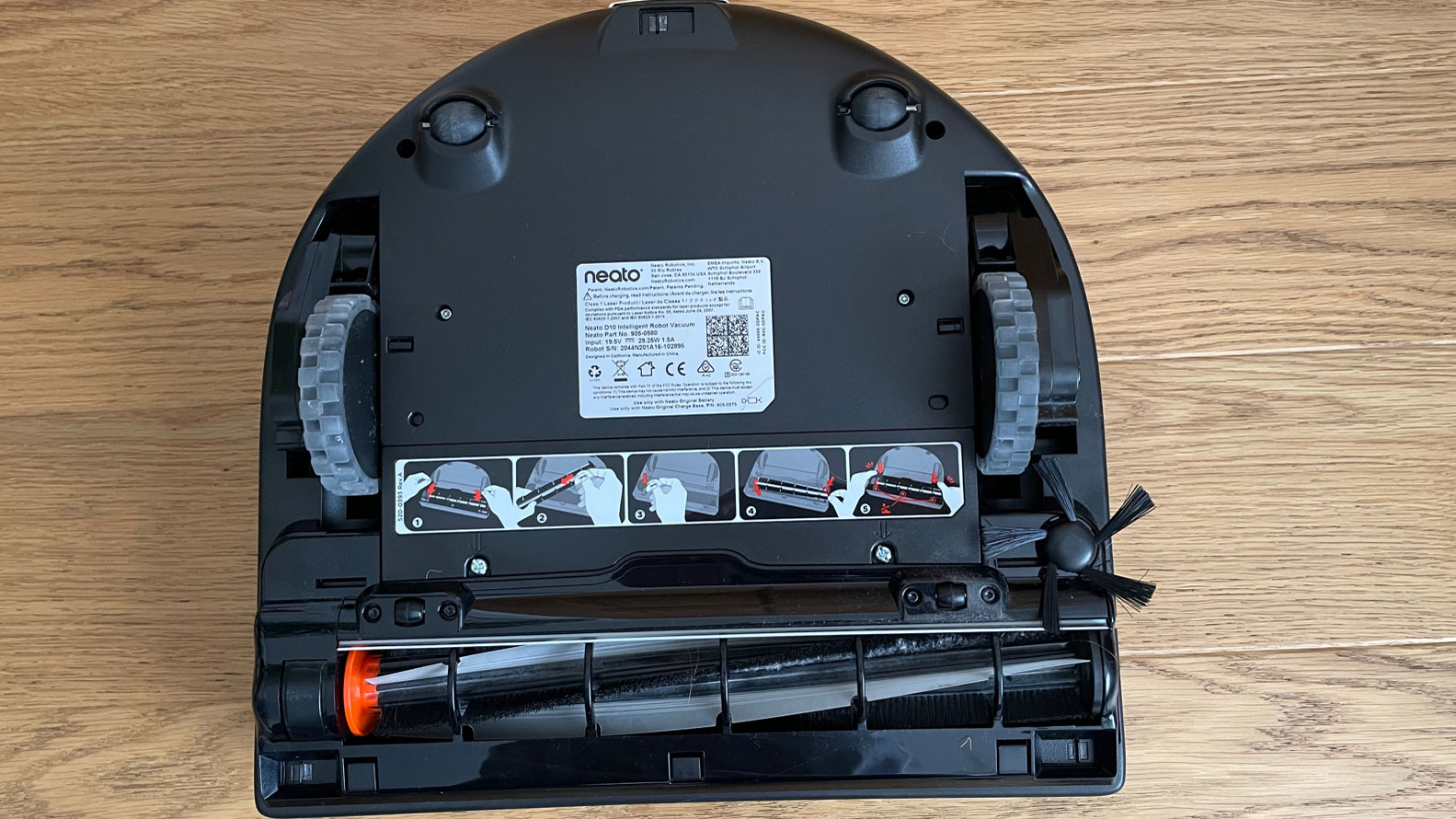
Neato D10: Features & accessories
- Slimline charging base
- Two spare HEPA filters
- Brush cleaning tool
The D10 is the only one of Neato’s latest vacuum range to include HEPA filtration, so if you suffer from allergies, this is the one for you. Internally, it’s decked out with all the latest and greatest technology available, including LIDAR mapping and navigation, as well as the all-important drop sensors so that it can avoid taking a tumble down your stairs.
There are three suction levels to choose from: eco, turbo, and max. In eco mode, the battery can last for up to 300 minutes, which is enough time for the robot to cover up to 2700 sq. feet, more than enough for most households. In the higher power modes, the battery gets used up faster, but when it drops down to 15%, the robot will automatically return to the charger, and it’ll resume cleaning as soon as it has enough power.
The accompanying app is where you’ll be able to access the majority of the robot's smart features as well as adjust the suction level. The robot also maps your floor plan, displaying it in the app, so you can then add no-go zones in areas you want it to avoid.
Furthermore, there’s an option to mark out cleaning zones or rooms, such as the kitchen or laundry room. This means when setting cleaning schedules, you can create different schedules for different zones, which is super handy if you want your kitchen cleaned more frequently than your living room, for example.
The cleaning schedules prompt the vacuum to start cleaning automatically at specified times and on specified days, which means you don’t even need to be home for cleaning to commence. It’s the ultimate in convenience.
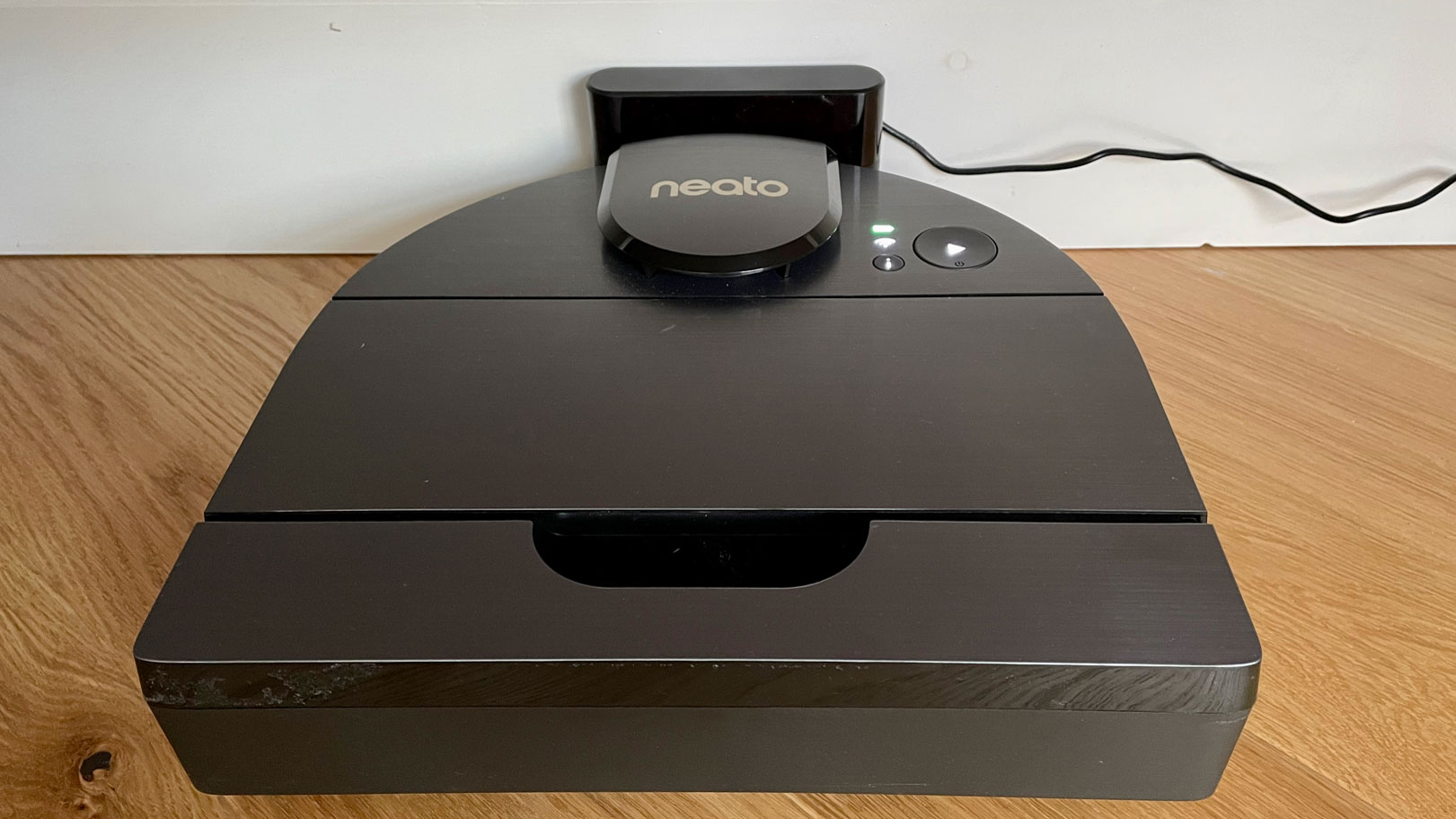
Once the app has been configured, the robot has to be sent off on its first full clean so that it can map your home. After the map has been created, you can then access further features within the app, such as the ability to create no-go zones.
Getting to grips with the app and all it has to offer is a pretty straightforward process, but it has a few quirks that I found frustrating. Firstly, when I moved the robot to a different floor of my home, it created a second-floor plan, but I couldn’t give each floor plan a different name, such as upstairs and downstairs. Furthermore, when I created no-go zones on one map, they were applied to both, so I had to remember to adjust these when moving the robot vacuum between floors.
Neato D10: Performance
The robot successfully mapped my floorplan, and after I'd set up the no-go zones, it was reassuring to watch it observe them. In general, I watched it take a logical path around rooms, and for the most part, it covered all areas. Having said that, on one occasion, it completely missed a spill of oats near a baseboard, but from what I saw, this wasn’t the norm.
As you’d expect, the Neato D10 performs best when on the max suction mode, and on the whole, it diligently cleans up everything in its path, from fine dust to larger debris and hair. The max suction mode is its loudest mode, and I recorded a noise level of 75dB on hard floors, which is about average for a vacuum, but this drops down to just 60dB in eco mode.
In comparison to other robot vacuums we’ve reviewed, it transitions well across uneven thresholds, making it a great choice if you’ve got slight changes in floor heights between rooms. But the drawback is that when it encounters low pieces of furniture, like the base of a lamp or even a fire hearth, it tends to climb onto them, which isn’t always ideal. In fact, if you’ve got pricey or easily scratched furniture, this could be a deal breaker.
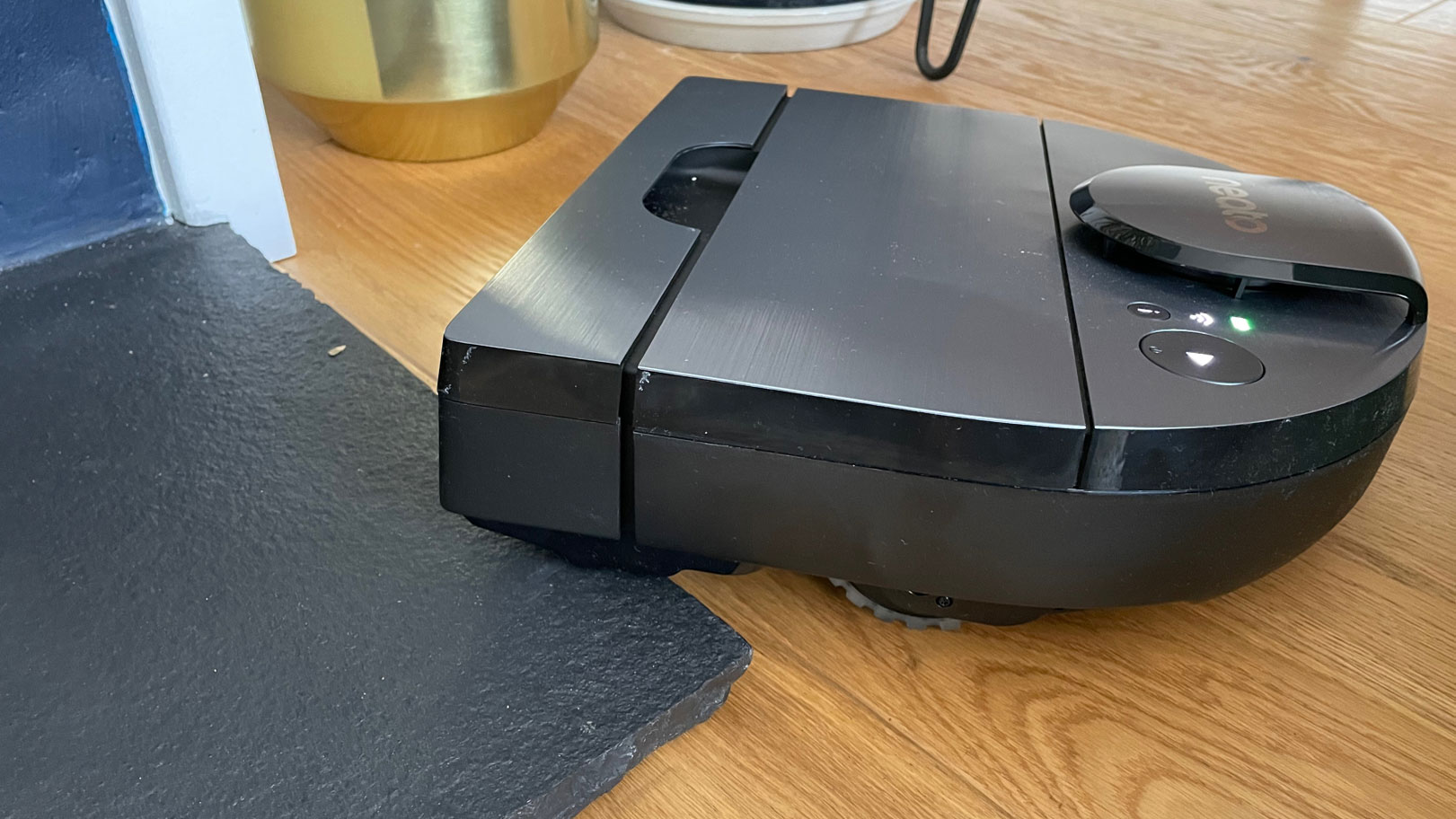
Performance was good on all floor types, and the Neato D10 coped well when faced with a long pile area rug. But I was disappointed that the D-shape – which is designed for better reach into corners – didn’t actually make corner or edge cleaning any better than other round robots we’ve reviewed. In fact, the wide, flat front edge meant it couldn’t always squeeze through gaps between chair legs that are big enough for a round robot to navigate or at least reach part way into.
When I took it upstairs, I left the charger downstairs, and at the end of the cleaning, when it couldn’t find the charger, instead of simply switching off, it began repeatedly bumping into the wall near where it started. Based on this experience, the next time I took it upstairs, I also took the charger and plugged it in. That way, the vacuum found its way home without headbutting the walls repeatedly.
The app notifies you if there’s a fault, for example, when the brush becomes tangled with hair and stops working. This was easily rectified, and I got the vacuum going again within minutes. It would be nice if the app also notified you when the dustbin needs emptying, but it lacks this feature. In general, though, apart from the frustrations I mentioned earlier, I found the app easy enough to navigate and use.
In terms of battery life, when in eco mode, a 33-minute clean uses just 11% of the battery, which means it’ll offer close to the advertised 300 minutes. Max mode used 24% of the battery in a 39-minute clean, which works out to a 160-minute run time. I think this is good going considering it’s on the highest suction level. It’s worth noting, though, that once the battery is at 15%, the robot returns to the charger – so you won’t benefit from the full run time. I timed a complete charge, and it took four hours to go from 15% to 100%.
Neato D10: Care & maintenance
The great thing about robot vacuums is that you don’t have to worry about where to store them; you simply have to think about where the charging dock will be placed. But as is common for robot vacuums, the dustbin on this Neato model is small and will need to be emptied frequently. That is a simple process, however, as it lifts out of the top of the vacuum easily.
For top performance, the brushes should be checked and cleaned every time the bin is emptied. A cleaning tool stored in the charging dock helps with removing hair that’s become tangled in the brushes. The filter should also be cleaned regularly, and it’s important to wipe the sensors so that the robot can continue to detect stairs and edges.
Neato recommends replacing the filters every 1-2 months, brushes should be replaced every 6-12 months, and batteries every 12-18 months. These are all easy to replace and are readily available to purchase from Neato.
The 1-year warranty is shorter than I'd like and robot vacuums aren’t as easy to repair yourself as some other types of vacuum. However, you can buy some replacement parts, such as a charging dock, from Neato.
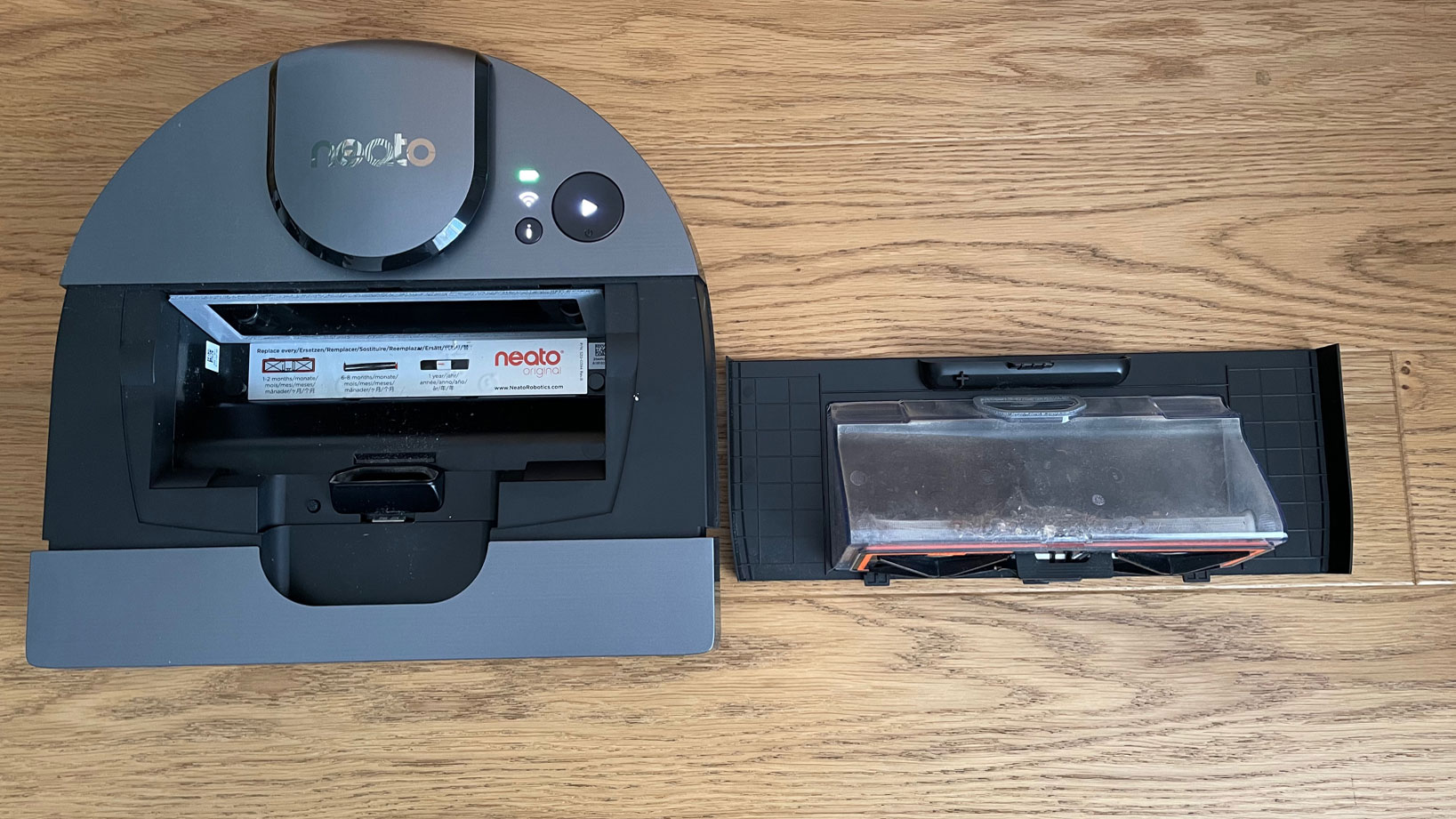
Neato D10: User reviews
It’s hard to judge the D10’s Amazon star rating because the reviews for the D7 appear to be combined with those for the D10, which means the star rating isn’t much help. And since this is a recently launched robot vacuum, it’s not yet widely rated.
However, the existing reviews from users praise the vacuum’s performance, with one user stating that it has “Great suction power that removes dog hair and dirt from hard floors, rugs, and carpet all from an easy-to-set-up app on my phone or via Alexa.” Another compliment is its navigation skills and the fact that it “manages to cover nearly every tiny nook and cranny - which is often where dog hair tends to collect”.
But not everyone likes that the app is so vital to access all the controls and features, and some would prefer there were more buttons on the robot itself. Others have experienced issues with the robot not being able to return to the charging base.
Neato D10: Expert opinion
I spoke to Howard Leyda, Vice President of Global Marketing and Ecommerce at Neato, who told us that the “goal at Neato Robotics is to relieve our users from mundane chores like vacuuming, so they have more time to spend with friends and family.”
Even the smallest allergens do not escape the Neato D10 and its true HEPA filter that captures up to 99.97% of allergens, fine dust particles, and even microbes as small as 0.3 microns.
Howard Leyda, VP Global Marketing, Neato
He gave us some insight into what makes the D10 a top performer. “The Neato D10 intelligent robot vacuum is perfect for families and people with larger homes. With its LaserSmart navigation efficiency and Spinflow vacuuming power, the Neato D10 delivers industry-leading vacuuming performance.”
Should you buy the Neato D10?
This is Neato’s most expensive robot vacuum, but it is currently on sale for $200, making it much more affordable. The HEPA filtration, coupled with long run times and good performance, means this is a robot vacuum that’ll suit most households.
But if you’re looking to use it on multiple stories, you’re likely to find the mapping features in the app frustrating. Additionally, those with very delicate or expensive furniture should be wary of the robots' penchant for trying to climb things.
How does the Neato D10 compare?
In terms of price, the Neato D10 is comparable to other top-performing vacuums, such as the Dyson V12 Detect Slim. The Dyson does offer a more thorough cleaning as well as the versatility to vacuum surfaces other than your floors, but it lacks the convenience of hands-off cleaning that you get with a good robot like the D10.
And if you want a robot that can do it all, the Yeedi Mop Station Pro is a similarly priced robot vacuum and can mop floors as well as vacuum them. But while it offers far more in terms of functionality, it’s a new brand that doesn’t have Neato’s pedigree. Plus, the docking station is massive, so it takes up a lot of space, and the runtime is much shorter than the D10’s.
If budget is your priority, it might be worth sacrificing the convenience of a robot for a decent plug-in vacuum. The Shark Navigator Lift Away offers excellent suction power for under $200. The catch is that it’s a bulky, old-school plug-in upright vacuum, and you’ll have to do the hard work yourself.
How I tested the Neato D10
Here at Top Ten Reviews, we feel strongly about giving consumers the best buying advice. As such, we test every product thoroughly in order to give an accurate opinion of its quality.
When we test vacuums, we make sure to take note of the packaging and unboxing, the assembly process, and how difficult it is, as well as the product's design and features and how it compares to the competition.
Our reviewers really put vacuums through their paces, testing them in controlled conditions using crumbs, flour, and oats to measure how quickly and accurately the vacuum performs. They also make sure to test every accessory to assess its value and usefulness.
Last but not least, we care about making your purchases last. We've spoken to experts across the cleaning and small appliances industry to get the best care and maintenance advice for your vacuums.
